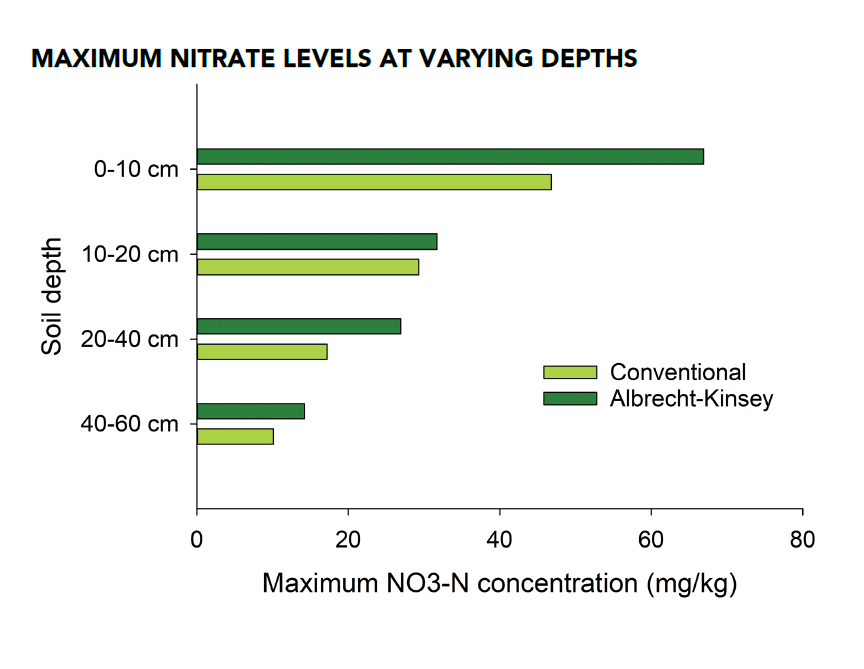Anne Lee
The Albrecht Kinsey approach to soil fertility has not provided a silver bullet in the quest to reduce nitrate leaching, a trial on a long-running Canterbury study at Back Track Dairies has found.
Proponents of the approach claim it can benefit the biology of the soil and improve nutrient retention.
But results from the field study which measured the amount of nitrogen at various soil depths through the late autumn, winter and early spring found that for nitrogen at least the Albrecht Kinsey approach didn’t help.
In fact, there was more nitrate nitrogen measured further down the soil profile heightening the risk of leaching although scientists point out that other factors were more likely to have been at play here – quite separate to any effect from the Albrecht Kinsey fertiliser approach.
Lincoln University senior lecturer in animal sciences Dr Racheal Bryant carried out the research through winter last year as part of the larger Back Track Dairies study into the alternative soil fertility approach.
Jeremy Casey and Kim Solly have been running the two dairy units in their equity partnership operation using the two different approaches since the farms were converted in 2012.
Fertiliser applications on the 155-hectare Whakapono farm, on the south side of Back Track, are made based on Albrecht Kinsey base cation saturation theories while the 210ha Waiora farm is fertilised based on conventional plant sufficiency fertiliser management.
The amount of nitrogen fertiliser applied on each farm has also been different with the conventionally managed farm receiving 151kg N/ha/year on average from 2014-2018 and the Albrecht Kinsey-run farm receiving 115kg N/ha/year.
Total pasture production has been similar on both farms with slightly more clover on the Albrecht Kinsey farm.
Jeremy has used urea applications as a means to boost pasture as needed based on round lengths and feed supply demand but has used notably lower rates on both farms than typically seen on Canterbury dairy conversions.
Last season though, in an effort to bring the conventional farm more in line with the Canterbury norm, he increased the rate to 167kg N/ha.
The Albrecht Kinsey farm received 89kg N/ha.
Other than that, both units are managed similarly.
‘The pasture has been actively growing at a greater rate and taking up the nitrogen over that period whereas the pastures in the trial area on the Albrecht Kinsey-managed farm were slower growing, leaving more nitrogen in the soil which was then free to move down the soil profile with drainage.’
Racheal says five paddocks were used on each farm and paired for the field study based on grazing dates through the last two grazing rounds.
Within each paddock three 10m x10m sites were selected and within them four smaller quadrats set up.
Two litres of artificial urine standardised to 600kg N/ha was applied to areas within those quadrats to simulate a urine patch.
Soil core samples were then taken from both the simulated urine patch areas and non-urine patch areas so that soil could be sampled at four depths from 0-10cm, 10-20cm, 20-40cm and 40-60 cm.
The sampling was repeated four times through to early August before the cows returned to the paddocks.
Both nitrate and ammonium levels were tested at each depth.
Racheal found that at the start of the trial although there was no difference in nitrate levels between the two farms at all depths, the Albrecht Kinsey-treated soils had significantly higher nitrate nitrogen levels at the 20-60cm depth when tested from day 20 right through to 70 days after the urine was applied.
Pasture measurements were also taken and showed significantly more pasture grew through the winter on the conventional farm.
“That’s likely to be the major reason behind lower levels of nitrate in the conventional soils.
“The pasture has been actively growing at a greater rate and taking up the nitrogen over that period whereas the pastures in the trial area on the Albrecht Kinsey-managed farm were slower growing, leaving more nitrogen in the soil which was then free to move down the soil profile with drainage.
“At the paddock level we can’t say the Albrecht Kinsey approach increased the chances of nitrate leaching but at the urine patch level we can say it didn’t offer any solutions as a way of retaining nutrient in the soil as some people promote.”
Racheal says differences in pasture growth may have been associated with differences in pasture species.
More clover in the Albrecht-Kinsey system means less grass to grow during the winter as clover has very low growth in winter compared with perennial ryegrass.
Indirectly more clover is the result of less N fertiliser on the Albrecht-Kinsey farm, she says.

Ironically the extra grass growth meant that despite the conventional farm having almost double the nitrogen fertiliser applied through the season it showed less leaching potential in this case.
“It could be more of a nitrogen story here than anything else but we have to be careful to draw conclusions for the whole farm based on the plot trial.”
“It gets complicated by differences in timing of application, seasonal effects, a number of things.”
The farm-scale Overseer budget comparisons have shown no significant difference between the two farms in the past until last season when the conventional farm’s Overseer nitrate loss number was more than 10 units higher as a result of the increased nitrogen fertiliser rates.
“In terms of nitrate losses, I think the trial confirms the Albrecht Kinsey approach isn’t going to be a silver bullet and it’s the things we already know about such as reducing autumn deposition of nitrogen and having winter active plant species that offer the best solutions at the moment.”





